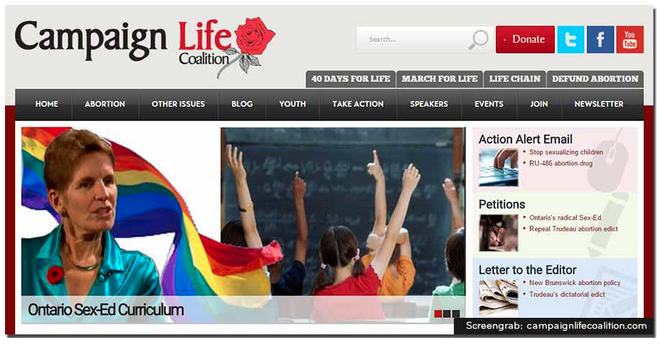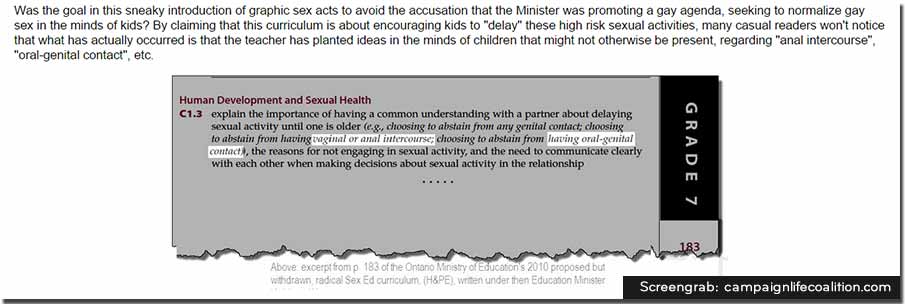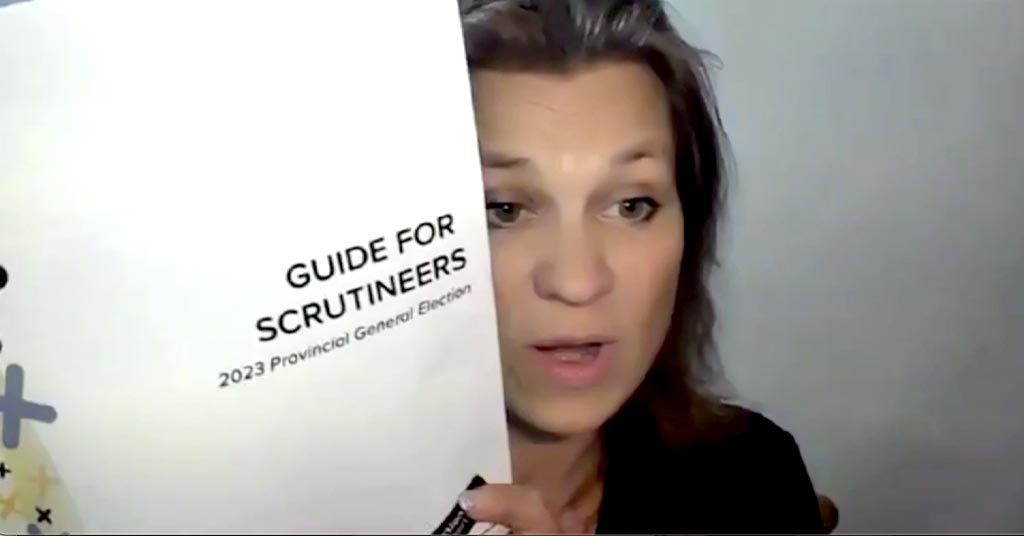
Pro-life group fears “gay agenda” will plant ideas in the minds of Ontario’s school kids
Cover your ears and avert your eyes, children! Canada’s biggest pro-life group says Ontario’s government will harm young children by introducing a “radical” new sexual education curriculum in 2015 — one largely based on an update the government first considered in 2010. Campaign Life Coalition sats Ontario’s 2010 sex-ed curriculum — the basis of the 2015 version to […]
Cover your ears and avert your eyes, children!
Canada’s biggest pro-life group says Ontario’s government will harm young children by introducing a “radical” new sexual education curriculum in 2015 — one largely based on an update the government first considered in 2010.
Campaign Life Coalition sats Ontario’s 2010 sex-ed curriculum — the basis of the 2015 version to be unveiled early this year — encourages “immoral” sex acts, and criticizes it for introducing concepts like gender identity, sexual identity, sexual body parts and homosexuality.
Campaign Life Coalition says Ontario’s new curriculum will “normalize homosexual family structures” and could cause “serious sexual confusion in the minds of children.”

They also take exception with the discussion of concepts like “masturbation,” and “vaginal lubrication” in Grade 6, and “anal intercourse” and oral sex in Grade 7.
“Why exactly does Premier Kathleen Wynne want to get 12 an 14 year olds thinking about ‘anal intercourse’?” Campaign Life asks.
Campaign Life also says the “the gay-activist Premier of Ontario” and her government are being pressured by “groups who advocate for the normalization of sadism, group sex, anal play and viewing pornography.” The organizations Campaign Life lists as “radical” include the Ontario Physical and Health Education Association, Planned Parenthood, Queer Ontario and the Communist Party of Ontario.
What facts does Campaign Life bring to the table? Take a look at the evidence they unearthed:
The proposed 2010 curriculum introduces children at the cusp of puberty to “the idea of being ‘more than just friends’ and ‘going out’ with classmates whom they may ‘like’.” Campaign Life somehow takes the concept of “romantic dating” and connects a few dots all the way to “unsavoury” groups who promote S&M and bondage:

But wait, there’s more.
Did you know that teaching kids about what “different families” look like, or the idea that “each person” is “unique,” is all a ploy to pull the wool over children’s eyes? Campaign Life caught that one, too:

And it doesn’t stop there.
Did you know that warning teenagers to have “a common understanding with a partner about delaying sexual activity until one is older,” including “vaginal or anal intercourse,” is actually a “sneaky” way of planting “ideas in the minds of children that might not otherwise be present”?

Apparently, it isn’t good enough to tell kids to abstain from sex, because just by talking about sex you’re reminding kids that sex exists.
So instead of providing kids with balanced information on safe sexual practices, Campaign Life advocates, for example, telling kids that anal sex will more than likely lead to death:
“If the government’s going to talk about anal sex at all, it should be at older ages and the message should be “That’s a risky, potentially fatal activity. Don’t do it”. The curriculum makes no mention that anal intercourse, in the context of male-on-male sex, leads directly to the death of a large percentage of those who practice it, and is generally unhealthy for all practicioners. People have a right to know about serious health risks before they choose to engage in it.”
(And for those who’d like to hear from a health authority on the matter, see here.)
Social conservatives have long opposed the Ontario government’s plans to update the sexual education curriculum – former premier Dalton McGuinty backed down from making changes in 2010 when he was attacked by a small and vocal group of Christian parent groups and got “cold feet and left our students using outdated materials,” as NDP education critic Peter Tabuns put it.
Ontario’s current sex-ed curriulum (in place since it was implemented by the Mike Harris government in 1998) has been called “the most outdated sex education and health curriculum in the country” and the Ontario Physical and Health Education Association says “youth are being left to fill in some important gaps on their own.”
With the new curriculum set to be introduced in classrooms this fall, the same conservative opposition groups are back demanding Ontario “stop corrupting children.”
For one parent’s articulate endorsement of the new curriculum, read Today’s Parent.
OPHEAs report on Sexual Health Education in Schools Across Canada shows that Ontario’s current curriculum lags far behind other Canadian provinces – even among those seen to lean towards more conservative values like Alberta and Saskatchewan.
Here’s how they break down key differences between the current 1998 curriculum and the one proposed in 2010, and where other provinces stand:
Naming body parts
Considered an important lesson so that students can communicate clearly in case of injury or abuse:
- 1998 curriculum: Grade 1’s identify major parts of the body by their proper names.
- 2010 revised curriculum: Grade 1’s identify body parts including genitalia (e.g. penis, testicles, vagina, vulva), using correct terminology.
- Alberta, British Columbia, New Brunswick and Manitoba require students to identify body parts in kindergarten. In Saskatchewan, students are not required to identify body parts using correct terminology until Grade 5.
Puberty
At issue is making sure students “learned factual information before they reached an age where they were likely to need the information to make decisions about their health and well-being.”
- 1998 curriculum: Grade 5’s describe physical, emotional, and interpersonal changes associated with puberty, and the secondary physical changes at puberty (e.g., growth of body hair, changes in body shape)
- 2010 curriculum: Grade 4’s describe the physical changes that occur in males and females at puberty, and the emotional and social impacts that may result from these changes.
- B.C. and Alberta require students to describe changes caused by puberty in Grade 4. Saskatchewan, New Brunswick and Manitoba require students to describe changes by Grade 5.
Sexual Diversity
Difference:
- 1998 (Grades 1-3): Distinguish the similarities and differences between themselves and others (e.g. in terms of body size or gender)
- 2010 (Grades 1-3): Grade 3’s discuss how visible and invisible differences make each person unique (including sexual orientation) and identify ways of showing respect for differences in others.
- Alberta and New Brunswick students are required to identify physical differences between Grades 1-3. Saskatchewan and Manitoba require students to recognize social and cultural influences that shape identity between Grades 1-3. Saskatchewan students explore different family structures (i.e. two-parent, single-parent, foster, extended, same-sex) in Grade 3.
Gender:
- 1998 Grades 7-8): nothing
- 2010 (Grades 7-8): Grade 8’s must demonstrate an understanding of gender identity and sexual orientation, and identify factors that can help individuals of all identities and orientations develop a positive self-concept.
- Alberta, Saskatchewan and Manitoba require students to identify the effects of gender identity in Grade 7.
Stereotypes:
- 1998 (Grades 4-6): nothing
- 2010 (Grades 4-6): Grade 6’s assess the effects of stereotypes, including homophobia and assumptions regarding gender roles and expectations, sexual orientation, race, ethnicity or culture, mental health, and abilities, on an individual’s self-concept, social inclusion, and relationships with others, and propose appropriate ways of responding to and changing assumptions and stereotypes.
- Other provinces have equivalent expectations for students ranging from Grade 4 in Alberta to Grade 6 in B.C.
Photo: Karloff. Used under creative commons BY-NC-SA 2.0 license.
Our journalism is powered by readers like you.
We’re an award-winning non-profit news organization that covers topics like social and economic inequality, big business and labour, and right-wing extremism.
Help us build so we can bring to light stories that don’t get the attention they deserve from Canada’s big corporate media outlets.
Donate



